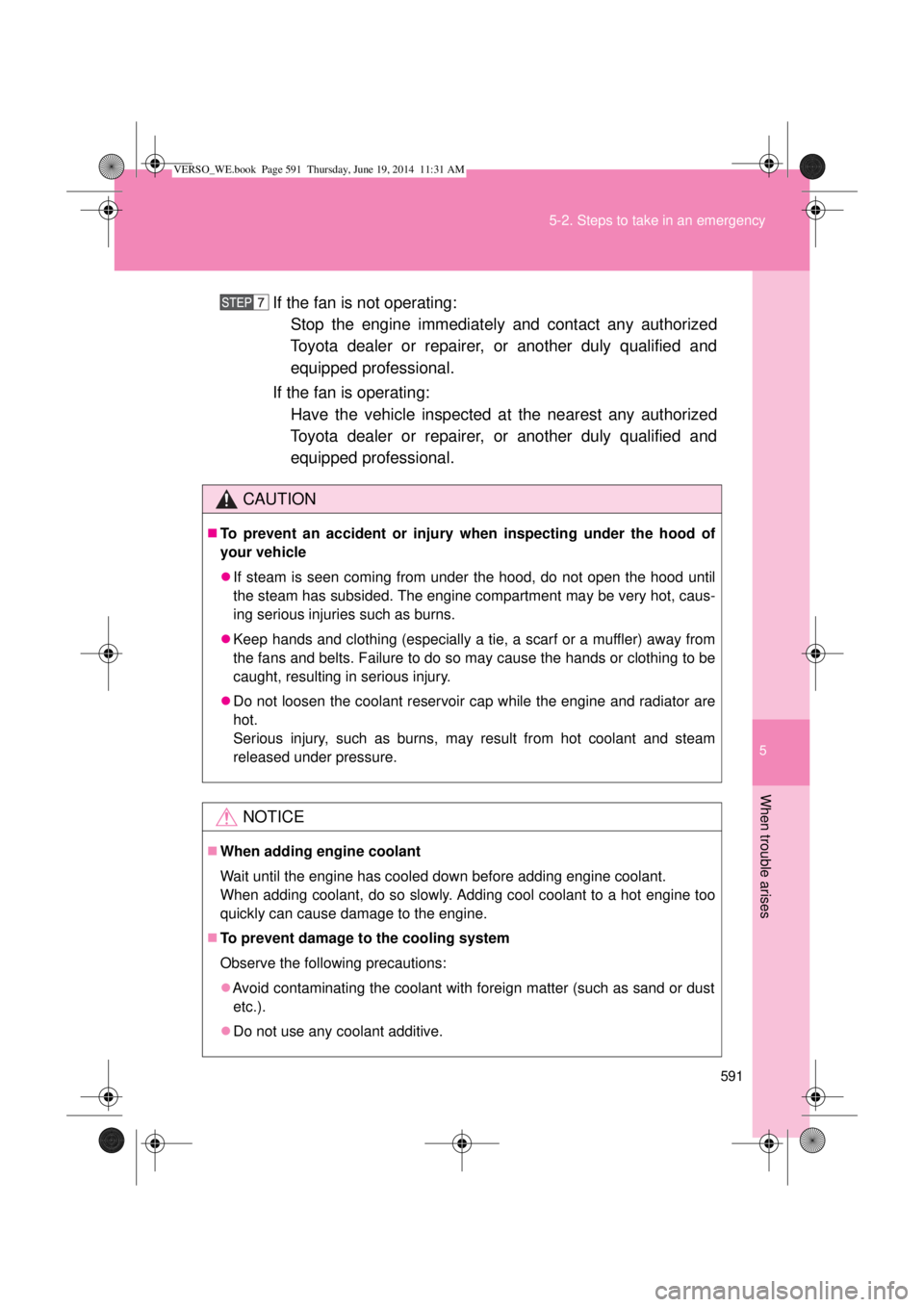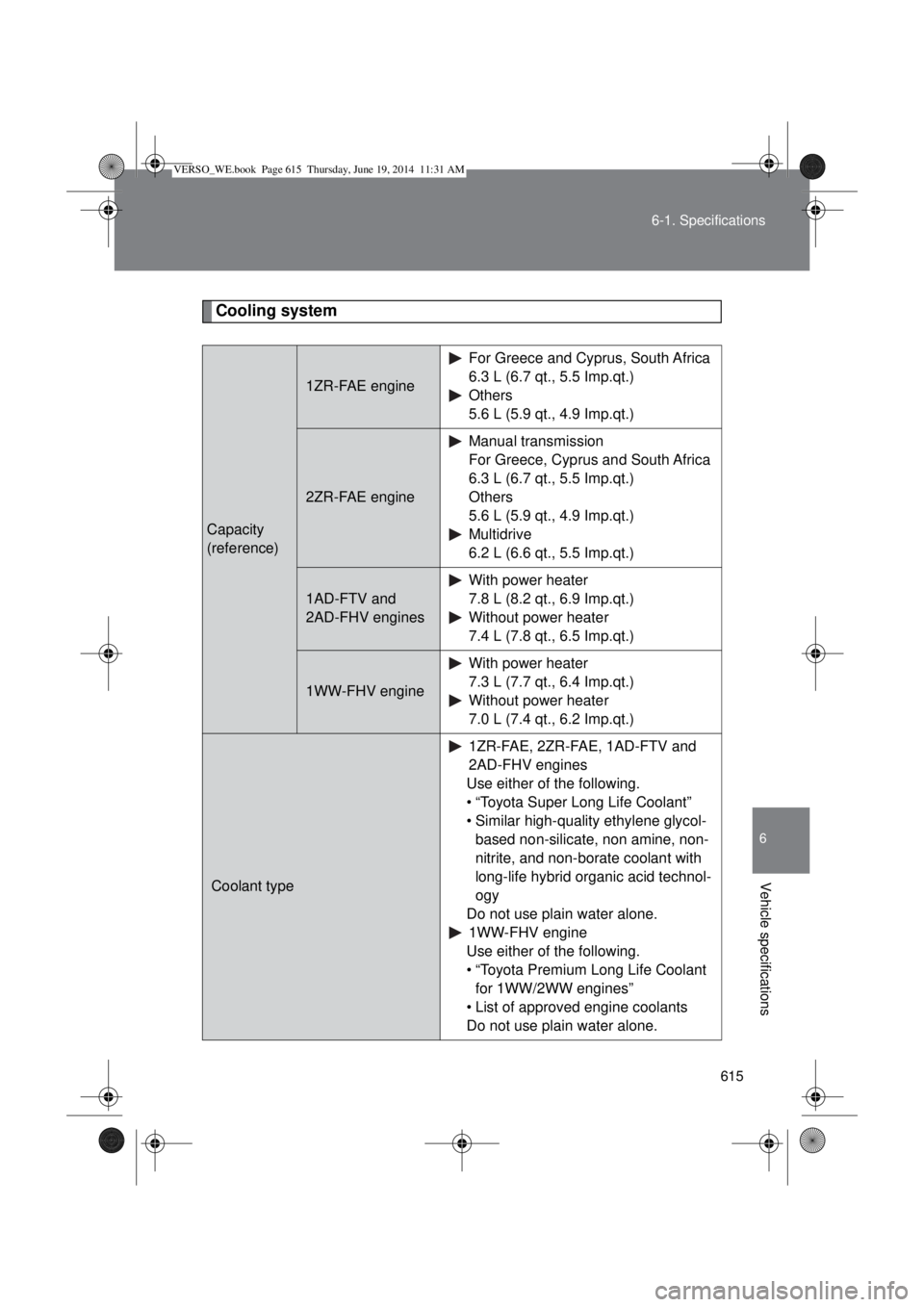Page 588 of 650
588 5-2. Steps to take in an emergency
NOTICE
To prevent damaging the vehicle (vehicles with a manual transmission)
Do not pull- or push-start the vehicle, because the catalytic converter may
overheat and become a fire hazard.
When handling jumper cables
Be careful that the jumper cables do not become tangled in the cooling fan
or any of the belts when connecting or disconnecting them.
VERSO_WE.book Page 588 Thursday, June 19, 2014 11:31 AM
Page 589 of 650
5
589
5-2. Steps to take in an emergency
When trouble arises
If your vehicle overheats
Correction procedures
Stop the vehicle in a safe place and turn off the air condition-
ing system, and then stop the engine.
If you see steam:
Carefully lift the hood after the steam subsides.
If you do not see steam:
Carefully lift the hood.
After the engine has cooled down sufficiently, inspect the
hoses and radiator core (radiator) for any leaks.
Gasoline engine
Radiator
Cooling fan
If a large amount of coolant leaks,
immediately contact any autho-
rized Toyota dealer or repairer, or
another duly qualified and
equipped professional.
The following may indicate that your vehicle is overheating.
The high engine coolant temperature warning light (P. 514)
comes on or flashes, or a loss of engine power is experienced.
(For example, the vehicle speed does not increase.)
Steam comes out from under the hood.
VERSO_WE.book Page 589 Thursday, June 19, 2014 11:31 AM
Page 590 of 650
590 5-2. Steps to take in an emergency
Diesel engine
Radiator
Cooling fans
If a large amount of coolant leaks,
immediately contact any autho-
rized Toyota dealer or repairer, or
another duly qualified and
equipped professional.
The coolant level is satisfactory if
it is between the “FULL” and
“LOW” lines on the reservoir.
Reservoir
“FULL”
“LOW”
Add coolant if necessary.
Water can be used in an emer-
gency if coolant is unavailable.
Start the engine and turn the air conditioning system on to
check that the radiator cooling fan operates and to check for
coolant leaks from the radiator or hoses.
The fan operates when the air conditioning system is turned on
immediately after a cold start. Confirm that the fan is operating by
checking the fan sound and air flow. If it is difficult to check these,
turn the air conditioning system on and off repeatedly.
(The fan may not operate in freezing temperatures.)
VERSO_WE.book Page 590 Thursday, June 19, 2014 11:31 AM
Page 591 of 650

5
591 5-2. Steps to take in an emergency
When trouble arises
If the fan is not operating:
Stop the engine immediately and contact any authorized
Toyota dealer or repairer, or another duly qualified and
equipped professional.
If the fan is operating:
Have the vehicle inspected at the nearest any authorized
Toyota dealer or repairer, or another duly qualified and
equipped professional.
CAUTION
To prevent an accident or injury when inspecting under the hood of
your vehicle
If steam is seen coming from under the hood, do not open the hood until
the steam has subsided. The engine compartment may be very hot, caus-
ing serious injuries such as burns.
Keep hands and clothing (especially a tie, a scarf or a muffler) away from
the fans and belts. Failure to do so may cause the hands or clothing to be
caught, resulting in serious injury.
Do not loosen the coolant reservoir cap while the engine and radiator are
hot.
Serious injury, such as burns, may result from hot coolant and steam
released under pressure.
NOTICE
When adding engine coolant
Wait until the engine has cooled down before adding engine coolant.
When adding coolant, do so slowly. Adding cool coolant to a hot engine too
quickly can cause damage to the engine.
To prevent damage to the cooling system
Observe the following precautions:
Avoid contaminating the coolant with foreign matter (such as sand or dust
etc.).
Do not use any coolant additive.
VERSO_WE.book Page 591 Thursday, June 19, 2014 11:31 AM
Page 615 of 650

615 6-1. Specifications
6
Vehicle specifications
Cooling system
Capacity
(reference)
1ZR-FAE engine
For Greece and Cyprus, South Africa
6.3 L (6.7 qt., 5.5 Imp.qt.)
Others
5.6 L (5.9 qt., 4.9 Imp.qt.)
2ZR-FAE engine
Manual transmission
For Greece, Cyprus and South Africa
6.3 L (6.7 qt., 5.5 Imp.qt.)
Others
5.6 L (5.9 qt., 4.9 Imp.qt.)
Multidrive
6.2 L (6.6 qt., 5.5 Imp.qt.)
1AD-FTV and
2AD-FHV engines
With power heater
7.8 L (8.2 qt., 6.9 Imp.qt.)
Without power heater
7.4 L (7.8 qt., 6.5 Imp.qt.)
1WW-FHV engine
With power heater
7.3 L (7.7 qt., 6.4 Imp.qt.)
Without power heater
7.0 L (7.4 qt., 6.2 Imp.qt.)
Coolant type1ZR-FAE, 2ZR-FAE, 1AD-FTV and
2AD-FHV engines
Use either of the following.
• “Toyota Super Long Life Coolant”
• Similar high-quality ethylene glycol-
based non-silicate, non amine, non-
nitrite, and non-borate coolant with
long-life hybrid organic acid technol-
ogy
Do not use plain water alone.
1WW-FHV engine
Use either of the following.
• “Toyota Premium Long Life Coolant
for 1WW/2WW engines”
• List of approved engine coolants
Do not use plain water alone.
VERSO_WE.book Page 615 Thursday, June 19, 2014 11:31 AM
Page 638 of 650

638 Alphabetical index
Back-up light
Replacing light bulb............... 484
Wattage................................. 624
Back door
Back door ................................ 79
Battery
Checking ............................... 434
If the vehicle has discharged
battery................................. 585
Preparing and checking
before winter ....................... 298
Bottle holders........................... 374
Brake
Parking brake ........................ 225
Brake assist.............................. 287
Break-in tips ............................. 185
Brightness control
Instrument panel light
control ................................. 232
Care
Exterior.................................. 402
Interior ................................... 406
Seat belts .............................. 407
Cargo capacity ......................... 295
Cargo hooks ............................. 392
CD player .................................. 334
Chains ....................................... 298
Child-protectors ......................... 75
Child restraint system
Baby seats, definition ............ 158
Baby seats, installation ......... 166
Child seats, definition ............ 158
Child seats, installation ......... 166
Installing CRS with ISOFIX
rigid anchor ......................... 172
Installing CRS with seat
belts .................................... 167
Installing CRS with top
straps .................................. 173Junior seats, definition .......... 158
Junior seats, installation ....... 166
Child safety
Airbag precautions ................ 153
Battery precautions ....... 436, 587
Child-protectors ...................... 75
Child restraint system ........... 158
How your child should wear
the seat belt ........................ 100
Installing child restraints ....... 166
Panoramic roof shade
precautions ......................... 116
Power window lock switch .... 112
Power window precautions ... 114
Removed key battery
precautions ......................... 468
Seat belt precautions ............ 101
Seat heater
precautions ......................... 384
Cleaning
Exterior ................................. 402
Interior................................... 406
Seat belts .............................. 407
Clock ........................................ 245
Condenser ................................ 433
Console box ............................. 371
Cooling system
Engine overheating ............... 589
Cruise control .......................... 265
Cup holders.............................. 373
Curtain shield airbags ............. 147
Customizable features ............ 629
Daytime running light
system .................................... 254
Deck board ............................... 392
Defogger
Rear window ......................... 326
Side mirrors .......................... 326
Dimension ................................ 598B
C
D
VERSO_WE.book Page 638 Thursday, June 19, 2014 11:31 AM